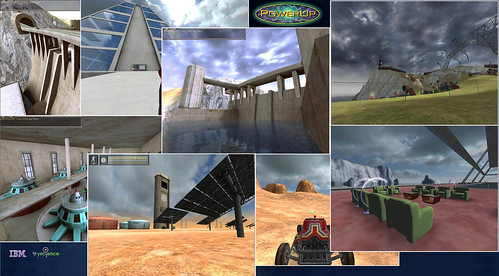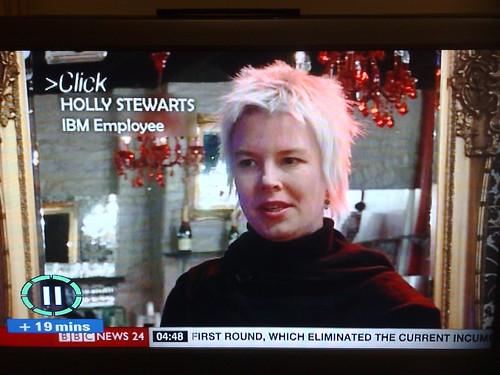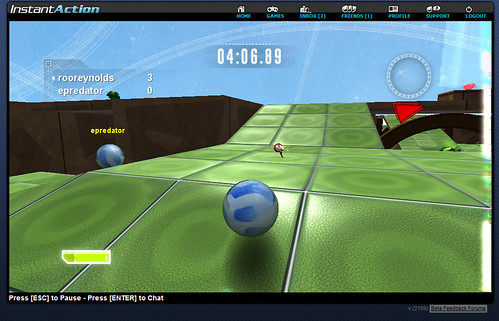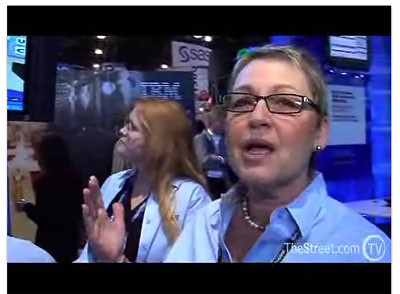Powerup the game recently went live created by our colleagues here in IBM using the Torque games engine.
It is a scenario based game, with a multiplayer online team approach to help students understand the role of science in saving a planet.
This fits into the growing usage and acceptance of game based technology and finding ways to engage people in serious subjects but in a more entertaining way.
The game is a downloadable windows client, that then connects to the main servers.

I captured a little video of some of the elements, the frame rate is much better live of course.
You get to select a first and second name from a list. This is to avoid any risky names I believe. So for once I am not epredator, but I did log on as Ian Hughes, imagine that! Though I did manage to only select the female avatar.
The rest of the communication is via menu systems, not freeform chat, again this is a protection mechanism given the target audience for the game.
Players can join missions, that are typically sharded ones and tasks are designed for more than one person to help complete.
The official website has much more information for parents and teachers. We here at eightbar cannot claim to have built any of this, though we have known about the development as its obviously closely related to our Torque based internal metaverse and is another spin off of bringing IBM into virtual worlds and games in general (which I think we can rightly claim to have set the ball rolling on 🙂 )
Monthly Archives: February 2008
Holly on the BBC, Its not all Roo and I on virtual worlds you know
At the VW Forum Europe in October Holly Stewart was thrown in front of the camera for a BBC click interview. Holly/Ada Alfa has been in with this since very early on and is very much core to eightbar. Not only that but she is currently the jointly elected guildmaster for our Virtual Universe Community.
It has taken a while but the BBC just ran it on BBC click as part of a virtual worlds piece. The page is here and UK people can watch the video.
A few small things, Its Holly Stewart not Stewarts, and the other IBMer is Paul Ledak not Paul Ladek, but you cant have everything can you.
**Update as Holly just pointed out on twitter the IBM SL machinima used in the piece was Rob Smart’s work too so credit where credit is due too 🙂
The key angle is also about interoperability, as you will notice this has been a bit of subject lately.
Anyway well to done our Holly for a great piece to camera. At last I cant take Click off series link on Sky+
Also greta perfomances from Valerie from ESC, the ubiquitous Justin from RRR and a great advert for Corey’s Multiverse in the middle of it.
Just for the record I think we (eightbar) have appeared on virtual worlds on click 3 times now in some way or another. Now where is the royalty cheque?

Exploring communication options in that metaverse middleground
As part of a bit of forward thinking I have been doing more experimenting with some levels of visualization. Working on the assumption that all video or all avatar is not the only way forward.
One way and another I ended up using Daz’s very amusing photo from flickr to illustrate the point here.
This is a mix of a static photo (an insane one) blended into an emotive 3d-ish representation, but with a synthesized voice from txt.
Daz crazy talked up from his 2d http://www.flickr.com/photos/shawdm/2… photo they will not read my mind
and speech synth lyrics by kanye west
I did a one of these the other day on my epredator.com blog which was a little more just to see if the technology worked, but also let me see if that would help in expressiveness and enhance a pure video conversation (which I think it does).
Here comes another wave of ideas for metaverses?
Metaverse technology and approaches to how people can interact in a MMO type way are appearing thick and fast. It always opens debates around one world versus many, it starts technical arguments around platforms. However that diversity is both a rich source of ideas and approaches and a restrictivce and confusing situation in social media circles.
Eric “Spin Martin” Rice comments on some of the problems of this in a recent post Just where and why are people choosing to gather in 3d spaces.
Recently Roo and I have been discussing the evolution of all these fragmented spaces. I dont think it is enough that we just tell people what is out there at the moment. It is by no means solved or possible may not be solvable, but it is worth considering some things here. Often interoperability reduces to a pure technical discussion when in fact its a social and organizational problem too. As virtual world companies and communities attempt to own their customers/members in a traditional sense they clearly want you to come to them to experience their wares and their way of doing things. This is a wider web2.0 conversation around who owns me and my stuff.
We are starting to see some words appear in up and coming virtual environments that start to hint at maybe some different metaphors. “Widgetized” is a forced word but if you read the press around RocketOn (props to Xantherus for twittering this company the other day) you start to see that we do not have to stick with the real world analogies that we have today. I am second guessing what Rocketon is doing but having a thing you take around with you from world to world appears to be their approach.
So I made a little picture, not so much a roadmap as a suggestion of where we are today and the ? as to where we need to evolve to in our understanding tomorrow. It is fairly self explanatory I hope.
We have gone from not knowing about anything going on around us, to our friends being online and sharing their thoughts/pictures/videos asynchronously to a set of single worlds where our avatar presence is part of the experience for us and those around us with a nominal amount of the previous steps awareness pulled into that environment too.
The trick is to think about the evolution from that, not to just replace real world metaphors but to extend them.
We already see this adoption as people start thinking about metaverses. They start with the replicas of themselves and of their offices and of their existing assets. They very quickly start to evolve their thinking and challenge why we need to stay on the floor in an office, do powerpoint, market with billboards etc. The non-real world representations start to flow as ideas.
My suggestion here is that the very container of those ideas, the world itself may also need to have this sort of evolutionary thought applied to it.
Single worlds and single avatars and a single live presence may be too restrictive, though is a comfortable metaphor to help people adopt metaverses and to feel some benefit from the.

This idea I think flows across each of the quadrants we see from the metaverse roadmap with the distinction being made with the types of virtual worlds and metaverses. Mirror Worlds, Virtual Worlds, Augmented Reality and Lifelogging.
Any thoughts?
Long Live the infocenter !
I’ve always been a bit scared of infocenters – even though, deep down, I know they’re “just HTML”; they never quite seem that way. Javascript and to-the-pixel object placement is just getting too good these days. You could almost mistake it for a java applet or at least some kind of fancy AJAX application.
But no, it’s just a set of good-old framesets, frames, HTML content, hyperlinks and images, bound together with some javascript eggwhite and stirred vigorously for a few minutes to make the infocenters we know and (some, I hear) love.
However, to make it seem like it’s “alive”, there is a Java servlet lurking back at the server, generating parts of the Infocenter dynamically, including rendering the Table of Contents from a behind-the-scenes XML description, and running search and bookmarks and things like that.
What I became curious about, then, were two things:
- Could we extract a sub-set of an infocenter and just display that, rather than having to wade through everything we were given? For example, I might only be interested in the administration section of a product, or might only need to know about one component of a toolkit of many components. Having a more navigable and less intimidating sub-set would greatly improve productivity.
- Rather than having to install an Eclipse infocenter run time on a server to host a set of documentation, is there a way to run it on any plain old HTTPd (e.g. Apache)? I accept that search, bookmarks, and other dynamic features won’t work, but the real information – the useful stuff in the right-hand window, which we use to do our jobs with the products we’re trying to understand; and the all-important navigational Table of Contents structure in the left-hand window – would be available to us “anywhere” we can put an HTTPd.
With a ThinkFriday afternoon ahead of me, I thought I’d see what could be done. And the outcome (to save you having to read the rest of this!) is rather pleasing: Lotus Expeditor micro broker infocenter.
This is a subset of the Lotus Expeditor infocenter containing just the microbroker component, being served as static pages from an Apache web server.
First the information content. The challenge I set was to extract the sections of the Lotus Expeditor documentation which relate to the microbroker component. It has always been a bit of a struggle to find these sections hidden amongst all the other information, as it’s in rather non-obvious places, and somewhat spread around. This means creating a new navigation tree for the left-hand pane of the Infocenter. When you click on a link in the navigation tree, that particular topic of information is loaded into the right-hand window.
However, it quickly became apparent that just picking the microbroker references from the existing nav tree would yield an unsatisfactory result: the topics need to be arranged into a sensible structure so that someone looking for information on how to perform a particular task would be guided to the right information topic. Just picking leaf nodes from the Lotus Expeditor navigation tree would leave us with some oddly dangling information topics.
Fortunately Laura Cowen, a colleague in the Hursley User Technologies department for messaging products, does this for a living, and so was able to separate out the microbroker wheat from the rest of the Expeditor documentation and reorganise the topics into a structure that makes sense out of the context of the bigger Expeditor Toolkit, but also, to be honest, into a much more meaningful and sensible shape for micro broker users
First we needed to recreate the XML which the infocenter runtime server uses to serve up the HTML of the navigation tree. Laura gave me a sample of the XML, which contains the title and URL topic link. From the HTML source of the full Expeditor navigation tree, using a few lines of Perl, I was able to re-create XML stanzas for the entries in the navigation tree. Laura then restructured these into the shape we wanted, throwing out the ones we didn’t want, and adding in extra non-leaf nodes in the tree to achieve the information architecture she wanted to create.
Wave a magic wand, and that XML file becomes a plug-in zip file that can be offered-up to an infocenter run time, and the resulting HTML content viewed. After some iterative reviews with potential future users of the micobroker infocenter, we finalised a navigation tree that balanced usability with not having to create new information topics, apart from a few placeholders for non-leaf nodes in the new navigation tree.
So far so good – we had an infocenter for just the microbroker component of Expeditor, and it was nicely restructured into a useful information architecture.
Now for phase two of the cunning plan: can we host that on a plain-old HTTPd without the infocenter run time behind it? The information topics (the pages that appear in the right-hand window) are static already, and didn’t need to be rehosted – the existing server for the Lotus Expeditor product documentation does a perfectly good job of serving up those HTML pages. It’s the rest of the Infocenter, the multiple nested framesets which make up the Infocenter “app”, and the all-important navigation tree, which are dynamically served, from a set of Java Server Pages (JSPs).
A quick peek at the HTML source revealed that several JSPs were being used with different parameter sets to create different parts of the displayed HTML. These would have to be “flattened” to something that a regular web server could host. A few wgets against the infocenter server produced most of the static HTML we would need, but quite a few URLs needed changing to make them unique when converted to flat filenames. A bit of Perl and a bit of hand editing sorted that lot out.
Then it transpired there is a “basic” and an “advanced” mode which the back-end servlet makes use of to (presumably) support lesser browsers (like wget 😐 ). Having realised what was going on, and a bit of tweaking of the wget parameters to make it pretend to be Firefox, and the “advanced” content came through from the server.
Then we had to bulk get the images – there are lots of little icons for pages, twisties, and various bits of window dressing for the infocenter window structure. All of this was assembled into a directory structure and made visible to an Apache HTTPd.
Et voila! It worked! Very cool! An infocenter for the microbroker running on a straight HTTPd. Flushed with success, we moved it over to MQTT.org (the friendly fan-zine web site for the MQ Telemetry Transport and related products like microbroker). Tried it there…
Didn’t work. Lots of broken links, empty windows and error loading page stuff. Seems the HTTPd on MQTT.org isn’t quite as forgiving as mine: files with a .jsp extension were being served back with the MIME type text/plain rather than text/html, which may not look like much, but makes all the difference. So a set of symlinks of .jsp files to .html files, and another quick wave of a perl script over the HTML files put everything right.
So with an afternoon’s work, we were able to demonstrate to our considerable satisfaction, that we could excise a sub-set of an Infocenter from a larger book, restructure it into a new shape, and take the resulting Infocenter content and flatten it to a set of HTML pages which can be served from a regular HTTP server.
IBM at the NRF
Does your avatar know how to make actual money? Bernadette Duponchel’s does. She was recently at the National Retail Federation conference with the rest of her team, presenting IBM’s take on virtual worlds for the fashion design industry.
This is the second consecutive year IBM has demonstrated the use of virtual worlds at the NRF. The brief demo highlights the benefits of real-time collaborative design, short feedback loops when tweaking materials and costs, and even pre-selling the item before it is physically manufactured.
Building cities by generation – Introversion
A recent conversation reminded me that I had read something in edge magazine about city generation for games. The premise being that whilst real places or soon to be real places may need to be hand crafted, sprawling believable cities that are backdrops or scenery, like forests or mountains, just be able to be generated. Of course ‘just’ hides the complexity of what needs to be done. The guys at introversion seem to be on the case though.
This video shows some of the toolkit in action as it decides how and where to layout a sprawling city.
There is more from the developers on their forum
I had seen this in a number of places on the web too like kotaku and digital urban it is certainly of interest in gaming community but procedural generation has its place in all sorts of content and simulation arenas.
Geek Rockets 2.0
We have just had a note to the emerging tech group here in Hursley inviting us to the 2nd rocket day. (I nearly said annual but it was back in September 2005 that we had the last one).
It reminded me that it was so long ago I had not youtubed the video I cut of the event. Unlike most video I do now which is small mobile snippets I had used a DV camera and then spent hours editing it up and cutting a soundtrack into it. Daz did a great one too with stills and a Kanye West track.
Making video like this is a very rewarding experience. So here is the 5 minutes of madness in a field in Hampshire.
Who knows, if I get to go to this maybe this will be a live webcast on epredator.tv into multiple virtual worlds (batteries and people willing)
March 5th Conference – Metaverse Evangelizing in a Web 2.0 world
Whilst Roo is off at SXSW doing his thing on March 5th/6th I will be at the Web 2.0 and Beyond: Applying Social and Collaborative Tools for Business Problems(this is the upcoming.org link) conference here in the UK explaining all things metaverse and also the use of Web 2.0 to move a corporation into action as we have done with eightbar and our various other creative outlets.
So if you are wondering what this is all about, and there is way more than just hearing me talk about life as epredator, then sign up and come along to this one.
The full page of speaker details are here, we also have Ian McNairn from IBM Software Group talking on day 2.
InstantAction in browser 3d multiplayer
As many of you know our IQ internal metaverse is based on the garage games Torque engine so we are always interested to see what is happening with it out there in the world. InstantAction.com teamed up with GarageGames to create this new multiplayer game experience in browser. The aim is to go way past the flash games approach and have a more detailed engine running that has grown up from game development.
So, being beta style Web2.0 people Roo, Rob and I dived in to see what it was like as the beta opened up some new games.
They have Marble Blast, Screwdriver and ThinkTanks all available as online or single player games.

Now the company is focused on all sorts of gaming experiences, a little past casual and puzzle games, aiming to exceed xbox live and playstation network.
It will be interesting to see how the dev kits help us in the future with corporate style intraverses. At the moment we still have a client install, though one that runs on mac, pc and linux for our metaverse. Also as instantaction is still in beta we have not explored what happens server side with interactions and persistence of worlds. I have no doubt someone is building something out there in garagegames land and I know we woudl love to see it.
For now lets enjoy the fact the games look pretty good and see where this develops.

